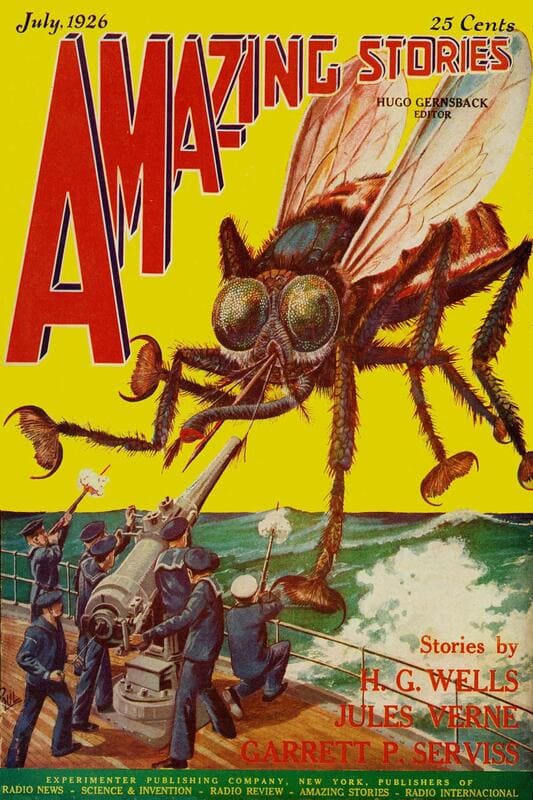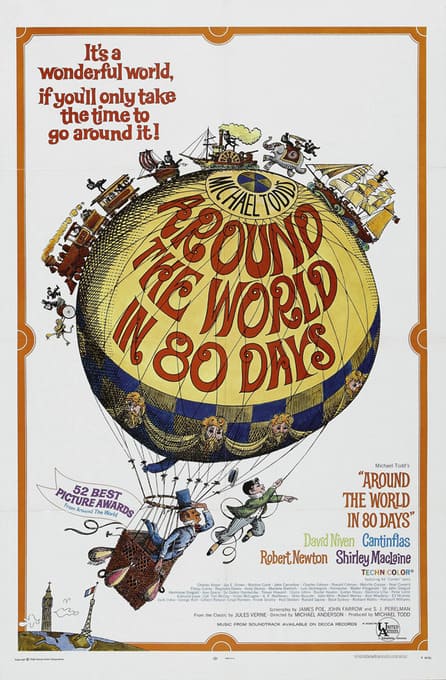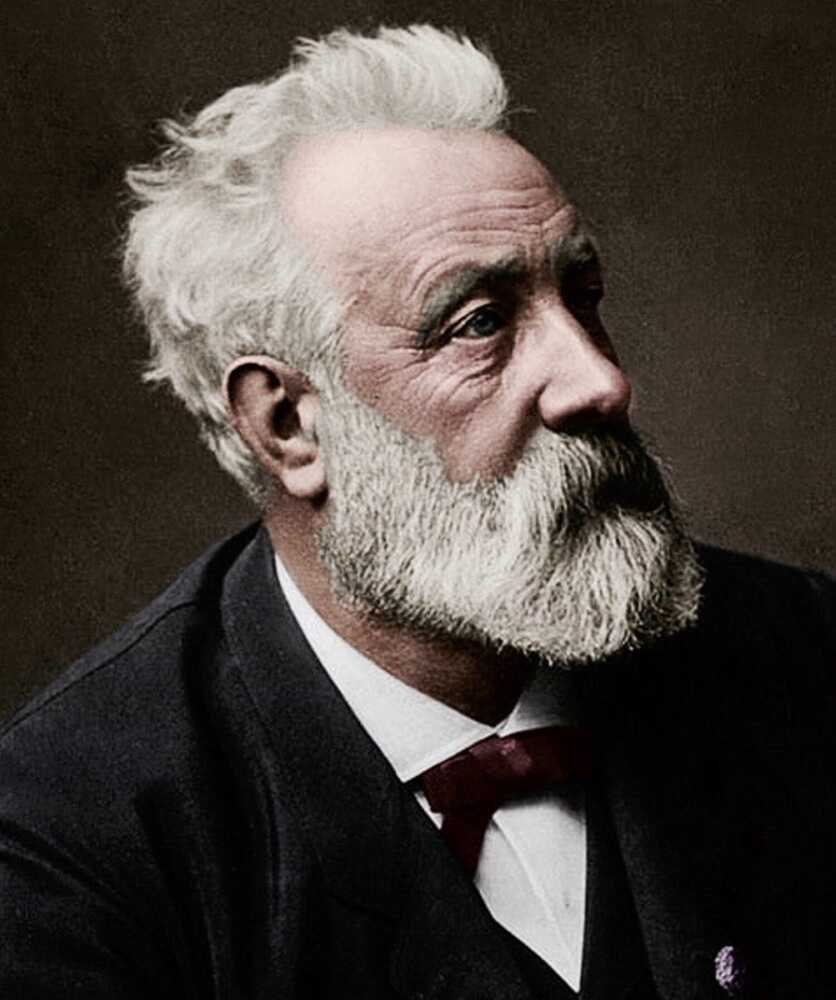The Voyages extraordinaires of Jules Verne
Not only can you travel personally, you can also travel without being in the place. Today we do it online through the internet. But 100 years ago it could also be done through literature. His ultimate expression of mind-blowing, fantastic and science-fiction trips was Jules Gabriel Verne.
Jules Verne and the United States
The United States is widely portrayed in the vernian bibliography: the state of Florida shares the stage with his work From the Earth to the Moon. Other works set entirely in the United States include An Eccentric’s Testament, Meteor Hunt, and Maston’s Secret.
Other important works partially set in this country are Around the World in Eighty Days and The Golden Volcano.
Curiously, in this book Verne leaves out the eccentric characters as he almost always portrays the American, the best example of him being J. T. Maston, who appears in three novels.

Jules Verne was born….
On February 8, 1828, Jules Verne was born, considered the father of modern science fiction, prolific author of adventure travel and science fiction. He was born in Nantes – France . He was the eldest of the 5 children of the marriage of Pierre Verne, a lawyer, and Sophie Allote de la Füye, from a shipowning family of Scottish descent.
In 1839, at the age of 11, he tried to escape on a ship to India, as a stowaway, but his father managed to arrest him on the same boat and beat him and imprisoned him with bread and water, as punishment. At 1840, they moved to Chantenay, near Nantes. In 1844, he was attending the Royal Lyceum of Nantes and began to write small prose poems at the age of 16. His father sent him to Paris to study law, so that Jules could follow in his footsteps as a lawyer.

Fall in love with literature
But Jules Verne fell in love with literature, especially theater. He wrote several works and libretti. He worked as secretary of the Lyric Theater (1852-54) and published short stories and scientific essays in the magazine Musée des familles. Alexander Dumas was his protector, when he had already become an authority on French letters, thanks to the publication of successful works such as The Three Musketeers or The Count of Monte Cristo
In 1856 he met Honorine Hebe du Fraysse de Viane, a young widow with 2 daughters, whom he married on January 10, 1857 and had Michel Verne. For years he worked as a broker on the Paris Stock Exchange. He continued writing, researching at the National Library and dreaming of a new type of novel that would combine scientific fact with adventure fiction. In 1859, he traveled through England and Scotland, and that inspired him to write later works.
He founded the Society for Air Research in 1862, and in September of that same year he met the publisher Pierre-Jules Hetzel, who agreed to publish the first of his books (Five Weeks in a Balloon – 1863).
Initially serialized in Hetzel’s Le Magasin d’éducation et de récréation, the novel became an international best seller, and Hetzel offered Verne a long-term contract to produce many more works of “science fiction.”
He was guaranteed the annual amount of 20,000 francs for the next twenty years.
Jules Verne left his job at the stock market to become a full-time writer and began what would turn out to be a highly successful author-publisher collaboration that lasted over 40 years and resulted in more than 60 works in the popular _Voyages extraordinaires_ series. , which appeared in monthly chapters in the aforementioned magazine Magasin d’education.
Verne’s works can be divided into three distinct phases.
First Stage
From 1862 to 1886, it is his positivist period. After his dystopian second novel _Paris au XXe siècle_. (written in 1863, kept in a safe, and published 130 years later, in 1994) was rejected by Hetzel in 1863, Jules Verne learned his lesson and for more than 20 years produced many highly successful scientific adventure novels, includin:
- Journey to the Center of the Earth – (1863, 1867)
- From the earth to the moon (1865)
- Around the moon (1870)
- Twenty Thousand Leagues Under the Sea (1870)
- Around the World in Eighty Days (1873)
In french
-
- Voyage au center de la terre (1863, 1867)
- De la terre à la lune (1865)
- Autour de la lune (1870)
- Vingt mille lieues sous les mers (1870)
- Le Tour du monde en quatre-vingts jours (1873)
In 1870, he was mobilized during the Franco-Prussian War as a Coast Guard soldier. By then Jules Verne he settled with his family in Amiens and made a short trip to the United States to visit New York and Niagara Falls.
He bought several ships, traveled the Atlantic and Mediterranean coasts, adapted some novels to the theater, gained world fame and a modest fortune.
Second Stage
He spans from 1886 until his death in 1905; it could be considered the pessimistic period of Verne.
Throughout these years the ideological tone of his _Voyages extraordinaires_ began to change. He turned away from the pro-science tales of exploration and discovery to explore the dangers of technology, which were elaborated by arrogant scientists in novels like:
- Upside Down (1889)
- Helix Island (1895)
- Facing the Flag (1896)
- Master of the World (1904).
In french
-
- Sans dessus dessous (1889)
- L’Île à helix (1895)
- Face au drapeau (1896)
- Maître du monde (1904).
This shift in focus also occurred in parallel to certain adversities in the author’s personal life. The growing problems with his son Michel; the financial difficulties that forced her to sell his yacht; the successive deaths of his mother and his mentor Hetzel; and the attack by a mentally challenged nephew who shot him in the leg, leaving him with a partial injury.
In 1892 he was distinguished as a Knight of the Legion of Honor.

Third Stage
When Jules Verne died in 1905, he left a drawer full of nearly finished manuscripts. This period, spanning from 1905 to 1919, could be considered the “Verne fils” stage; when his posthumous works were published by his son Michel, after having been extensively renovated.
They include:
- The Golden Volcano (1906),
- The Thompson and Co. Agency (1907),
- Meteor Hunt (1908)
- The Pilot of the Danube (1908)
In french
-
- Le Volcan d’or (1906),
- L’Agence Thompson and Co. (1907),
- La Chasse au météore (1908)
- Le Pilote du Danube (1908)
Original manuscripts vs published posthumous versions
Comparing the original manuscripts with published posthumous versions, the researchers found that Michel. Verne did much more than just edit them. In most cases he completely rewrote them, among other changes, recast the plots, added fictional characters and made his style more melodramatic.
Michel Verne died in 1925, and Verne’s literary legacy reached at the end. In 1926, American publisher Hugo Gernsback used a depiction of Verne’s grave as a logo for his – Amazing Stories -, the first literary magazine to feature “science” stories.
As the term “science” evolved into “science fiction,” the new genre began to flourish like never before, and Jules Verne was universally recognized as its creator. During the 20th century, Verne’s works were translated into more than 140 languages, making him one of the most translated authors in the world.
At the Cinema, from some of his novels made several successful films. (here)
He began in 1902 with the “Journey to the Moon”, by Georges Méliès; it followed in 1916 with “20,000 Leagues Under the Sea” (remade in 1954 by Walt Disney); and then: “The mysterious island” (1929 and 1961); “From the Earth to the Moon” (1958); “Journey to the center of the Earth” (1959); the popular one, “Around the World in 80 Days” (1956) …
His influence extends beyond Literature and Film to the world of science and technology, where he inspired generations of scientists, inventors and explorers.In 1954 the United States Navy launched the world’s first nuclear-powered submarine, christened the “Nautilus” after Verne’s.
And for more than 130 years, adventurers like Nellie Bly (1890), Wiley Post (1933) and Steve Fossett (2005) have followed in the footsteps of Jules Verne’s fictional hero, Phileas Fogg.
Published Jules Verne’s Works
| French title | English title | Year | ||
|---|---|---|---|---|
| Cinq Semaines en ballon | Five Weeks in a Balloon | 1863 | ||
| Voyages et aventures du capitaine Hatteras | The Adventures of Captain Hatteras | 1866 | ||
| Voyage au centre de la Terre | Journey to the Center of the Earth | 1864 | ||
| De la Terre à la Lune | From the Earth to the Moon | 1865 | ||
| Les Enfants du capitaine Grant | In Search of the Castaways | 1867–8 | ||
| Vingt Mille Lieues sous les mers | Twenty Thousand Leagues Under the Sea | 1869–70 | ||
| Autour de la Lune | Around the Moon | 1870 | ||
| Une Ville flottante | A Floating City | 1871 | ||
| Aventures de trois Russes et de trois Anglais | The Adventures of Three Englishmen and Three Russians in South Africa | 1872 | ||
| Le Pays des fourrures | The Fur Country | 1873 | ||
| Le Tour du monde en quatre-vingts jours | Around the World in Eighty Days | 1873 | ||
| L’Île mystérieuse | The Mysterious Island | 1874–5 | ||
| Le Chancellor | The Survivors of the Chancellor | 1875 | ||
| Michel Strogoff | Michael Strogoff | 1876 | ||
| Hector Servadac | Off on a Comet | 1877 | ||
| Les Indes noires | The Child of the Cavern | 1877 | ||
| Un Capitaine de quinze ans | Dick Sand, A Captain at Fifteen | 1878 | ||
| Les Cinq Cents Millions de la Bégum | The Begum’s Fortune | 1879 | ||
| Les Tribulations d’un Chinois en Chine | Tribulations of a Chinaman in China | 1879 | ||
| La Maison à vapeur | The Steam House | 1880 | ||
| La Jangada | Eight Hundred Leagues on the Amazon | 1881 | ||
| L’École des Robinsons | Godfrey Morgan | 1882 | ||
| Le Rayon vert | The Green Ray | 1882 | ||
| Kéraban-le-têtu | Kéraban the Inflexible | 1883 | ||
| L’Étoile du sud | The Vanished Diamond | 1884 | ||
| L’Archipel en feu | The Archipelago on Fire | 1884 | ||
| Mathias Sandorf | Mathias Sandorf | 1885 | ||
| Un Billet de loterie | The Lottery Ticket | 1886 | ||
| Robur-le-Conquérant | Robur the Conqueror | 1886 | ||
| Nord contre Sud | North Against South | 1887 | ||
| Le Chemin de France | The Flight to France | 1887 | ||
| Deux Ans de vacances |
Two Years’ Vacation |
1888 | ||
| Famille-sans-nom | Family Without a Name | 1889 | ||
| Sans dessus dessous | The Purchase of the North Pole | 1889 | ||
| César Cascabel | César Cascabel | 1890 | ||
| Mistress Branican | Mistress Branican | 1891 | ||
| Le Château des Carpathes | Carpathian Castle | 1892 | ||
| Claudius Bombarnac | Claudius Bombarnac | 1893 | ||
| P’tit-Bonhomme | Foundling Mick | 1893 | ||
| Mirifiques Aventures de Maître Antifer | Captain Antifer | 1894 | ||
| L’Île à hélice | Propeller Island | 1895 | ||
| Face au drapeau | Facing the Flag | 1896 | ||
| Clovis Dardentor | Clovis Dardentor | 1896 | ||
| Le Sphinx des glaces | An Antarctic Mystery | 1897 | ||
| Le Superbe Orénoque | The Mighty Orinoco | 1898 | ||
| Le Testament d’un excentrique | The Will of an Eccentric | 1899 | ||
| Seconde Patrie | The Castaways of the Flag | 1900 | ||
| Le Village aérien | The Village in the Treetops | 1901 | ||
| Les Histoires de Jean-Marie Cabidoulin | The Sea Serpent | 1901 | ||
| Les Frères Kip | The Kip Brothers | 1902 | ||
| Bourses de voyage | Travel Scholarships | 1903 | ||
| Un Drame en Livonie | A Drama in Livonia | 1904 | ||
| Maître du monde | Master of the World | 1904 | ||
| L’Invasion de la mer | Invasion of the Sea | 1905 |
Movies
- Journey to the Moon, 1902, directed by Georges Méliès.
- The 1951 Mysterious Island, directed by Spencer Gordon Benet and starring Richard Crane.
- 20,000 Leagues Under the Sea 1954, directed by Richard Fleischer with Kirk Douglas as Ned and James Mason as Captain Nemo.
- Miguel Strogoff from 1956, directed by Carmine Gallone and with Curd Jurgens as Miguel Strogoff.
- Around the World in 80 Days, 1956, directed by Michael Anderson with David Niven as Phileas Fogg and Cantinflas as Passepartout (or Passepartout).
- From the Earth to the Moon, 1958, directed by Byron Haskin with Joseph Cotten, Debra Paget and George Sanders.
- Journey to the Center of the Earth 1959, directed by Henry Levin and starring James Mason.
- Owner of the World 1961, directed by William Witney and starring Vincent Price.
- The Mysterious Island of 1961, directed by Cy Endfield with Michael Craig as the protagonist.
- The Children of Captain Grant from 1962, directed by Robert Stevenson and starring Maurice Chevalier, George Sanders and Hayley Mills.
- Five Weeks in a Balloon, 1962, directed by Irwin Allen with Red Buttons.
- The Light of the End of the World 1971, directed by Kevin Billington and performed by Kirk Douglas, Yul Brynner and Fernando Rey.
- 20,000 Leagues Under the Sea, 1997, directed by Rod Hardy and starring Michael Caine, Bryan Brown, Patrick Dempsey and Mía Sara.
- Around the World in 80 Days 2004, directed by Frank Coraci, produced by Disney with Jackie Chan.
- Jules Verne’s 2005 Mysterious Island, directed by Russell Mulcahy and portrayed by Kyle MacLachlan, Patrick Stewart, and Gabrielle Anwar.
- Journey to the Center of the Earth 2008, directed by Eric Brevig and performed by Brendan Fraser, Josh Hutcherson, and Anita Briem.
- The 2012 Mysterious Island, directed by Brad Peyton and starring Dwayne Johnson, Josh Hutcherson, Luis Guzmán and Vanessa Hudgens.
Related Post



